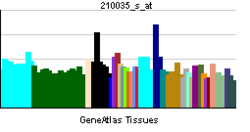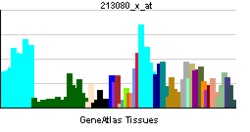60S ribosomal protein L5
| View/Edit Human | View/Edit Mouse |
60S ribosomal protein L5 is a protein that in humans is encoded by the RPL5 gene.[3][4]
Function
Ribosomes, the organelles that catalyze protein synthesis, consist of a small 40S subunit and a large 60S subunit. Together these subunits are composed of 4 RNA species and approximately 80 structurally distinct proteins. This gene encodes a ribosomal protein that is a component of the 60S subunit. The protein belongs to the L18P family of ribosomal proteins. It is located in the cytoplasm. The protein binds 5S rRNA to form a stable complex called the 5S ribonucleoprotein particle (RNP), which is necessary for the transport of nonribosome-associated cytoplasmic 5S rRNA to the nucleolus for assembly into ribosomes. The protein interacts specifically with the beta subunit of casein kinase II. As is typical for genes encoding ribosomal proteins, there are multiple processed pseudogenes of this gene dispersed through the genome.[5]
Clinical significance
Variable expression of this gene in colorectal cancers compared to adjacent normal tissues has been observed, although no correlation between the level of expression and the severity of the disease has been found. This gene is co-transcribed with the small nucleolar RNA gene U21, which is located in its fifth intron. As is typical for genes encoding ribosomal proteins, there are multiple processed pseudogenes of this gene dispersed through the genome.[5]
Interactions
Ribosomal protein L5 has been shown to interact with:
References
- ↑ "Human PubMed Reference:".
- ↑ "Mouse PubMed Reference:".
- ↑ Qu LH, Nicoloso M, Michot B, Azum MC, Caizergues-Ferrer M, Renalier MH, Bachellerie JP (November 1994). "U21, a novel small nucleolar RNA with a 13 nt. complementarity to 28S rRNA, is encoded in an intron of ribosomal protein L5 gene in chicken and mammals". Nucleic Acids Res. 22 (20): 4073–81. doi:10.1093/nar/22.20.4073. PMC 331892
 . PMID 7937132.
. PMID 7937132. - ↑ Frigerio JM, Dagorn JC, Iovanna JL (July 1995). "Cloning, sequencing and expression of the L5, L21, L27a, L28, S5, S9, S10 and S29 human ribosomal protein mRNAs". Biochim Biophys Acta. 1262 (1): 64–8. doi:10.1016/0167-4781(95)00045-i. PMID 7772601.
- 1 2 "Entrez Gene: RPL5 ribosomal protein L5".
- ↑ Lehner B, Semple JI, Brown SE, Counsell D, Campbell RD, Sanderson CM (January 2004). "Analysis of a high-throughput yeast two-hybrid system and its use to predict the function of intracellular proteins encoded within the human MHC class III region". Genomics. 83 (1): 153–67. doi:10.1016/s0888-7543(03)00235-0. PMID 14667819.
- ↑ Boldyreff B, Issinger OG (February 1997). "A-Raf kinase is a new interacting partner of protein kinase CK2 beta subunit". FEBS Lett. 403 (2): 197–9. doi:10.1016/s0014-5793(97)00010-0. PMID 9042965.
- ↑ Kim JM, Cha JY, Marshak DR, Bae YS (September 1996). "Interaction of the beta subunit of casein kinase II with the ribosomal protein L5". Biochem. Biophys. Res. Commun. 226 (1): 180–6. doi:10.1006/bbrc.1996.1330. PMID 8806611.
- ↑ Ahn BH, Kim TH, Bae YS (October 2001). "Mapping of the interaction domain of the protein kinase CKII beta subunit with target proteins". Mol. Cells. 12 (2): 158–63. PMID 11710515.
- ↑ Schatz O, Oft M, Dascher C, Schebesta M, Rosorius O, Jaksche H, Dobrovnik M, Bevec D, Hauber J (February 1998). "Interaction of the HIV-1 rev cofactor eukaryotic initiation factor 5A with ribosomal protein L5". Proc. Natl. Acad. Sci. U.S.A. 95 (4): 1607–12. doi:10.1073/pnas.95.4.1607. PMC 19115
 . PMID 9465063.
. PMID 9465063. - ↑ Zhang Y, Wolf GW, Bhat K, Jin A, Allio T, Burkhart WA, Xiong Y (Dec 2003). "Ribosomal protein L11 negatively regulates oncoprotein MDM2 and mediates a p53-dependent ribosomal-stress checkpoint pathway". Mol. Cell. Biol. 23 (23): 8902–12. doi:10.1128/mcb.23.23.8902-8912.2003. PMC 262682
 . PMID 14612427.
. PMID 14612427. - ↑ Marechal V, Elenbaas B, Piette J, Nicolas JC, Levine AJ (November 1994). "The ribosomal L5 protein is associated with mdm-2 and mdm-2-p53 complexes". Mol. Cell. Biol. 14 (11): 7414–20. doi:10.1128/mcb.14.11.7414. PMC 359276
 . PMID 7935455.
. PMID 7935455. - ↑ Dai MS, Sun XX, Lu H (July 2008). "Aberrant expression of nucleostemin activates p53 and induces cell cycle arrest via inhibition of MDM2". Mol. Cell. Biol. 28 (13): 4365–76. doi:10.1128/MCB.01662-07. PMC 2447154
 . PMID 18426907.
. PMID 18426907. - ↑ Kang MJ, Ahn HS, Lee JY, Matsuhashi S, Park WY (April 2002). "Up-regulation of PDCD4 in senescent human diploid fibroblasts". Biochem. Biophys. Res. Commun. 293 (1): 617–21. doi:10.1016/S0006-291X(02)00264-4. PMID 12054647.
Further reading
- Wool IG, Chan YL, Glück A (1996). "Structure and evolution of mammalian ribosomal proteins.". Biochem. Cell Biol. 73 (11-12): 933–47. doi:10.1139/o95-101. PMID 8722009.
- Pogue-Geile K, Geiser JR, Shu M, Miller C, Wool IG, Meisler AI, Pipas JM (1991). "Ribosomal protein genes are overexpressed in colorectal cancer: isolation of a cDNA clone encoding the human S3 ribosomal protein.". Mol. Cell. Biol. 11 (8): 3842–9. PMC 361167
 . PMID 1712897.
. PMID 1712897. - Steitz JA, Berg C, Hendrick JP, La Branche-Chabot H, Metspalu A, Rinke J, Yario T (1988). "A 5S rRNA/L5 complex is a precursor to ribosome assembly in mammalian cells.". J. Cell Biol. 106 (3): 545–56. doi:10.1083/jcb.106.3.545. PMC 2115095
 . PMID 3279045.
. PMID 3279045. - Hirano K, Ito M, Hartshorne DJ (1995). "Interaction of the ribosomal protein, L5, with protein phosphatase type 1.". J. Biol. Chem. 270 (34): 19786–90. doi:10.1074/jbc.270.34.19786. PMID 7649987.
- Marechal V, Elenbaas B, Piette J, Nicolas JC, Levine AJ (1994). "The ribosomal L5 protein is associated with mdm-2 and mdm-2-p53 complexes.". Mol. Cell. Biol. 14 (11): 7414–20. doi:10.1128/mcb.14.11.7414. PMC 359276
 . PMID 7935455.
. PMID 7935455. - Ogata K, Kurahashi A, Nishiyama C, Terao K (1994). "Presence of role of the 5SrRNA-L5 protein complex (5SRNP) in the threonyl- and histidyl-tRNA synthetase complex in rat liver cytosol.". Biochim. Biophys. Acta. 1218 (3): 388–400. doi:10.1016/0167-4781(94)90192-9. PMID 8049265.
- Maruyama K, Sugano S (1994). "Oligo-capping: a simple method to replace the cap structure of eukaryotic mRNAs with oligoribonucleotides.". Gene. 138 (1-2): 171–4. doi:10.1016/0378-1119(94)90802-8. PMID 8125298.
- Michael WM, Dreyfuss G (1996). "Distinct domains in ribosomal protein L5 mediate 5 S rRNA binding and nucleolar localization.". J. Biol. Chem. 271 (19): 11571–4. doi:10.1074/jbc.271.19.11571. PMID 8626719.
- Kim JM, Cha JY, Marshak DR, Bae YS (1996). "Interaction of the beta subunit of casein kinase II with the ribosomal protein L5.". Biochem. Biophys. Res. Commun. 226 (1): 180–6. doi:10.1006/bbrc.1996.1330. PMID 8806611.
- Boldyreff B, Issinger OG (1997). "A-Raf kinase is a new interacting partner of protein kinase CK2 beta subunit.". FEBS Lett. 403 (2): 197–9. doi:10.1016/S0014-5793(97)00010-0. PMID 9042965.
- Suzuki Y, Yoshitomo-Nakagawa K, Maruyama K, Suyama A, Sugano S (1997). "Construction and characterization of a full length-enriched and a 5'-end-enriched cDNA library.". Gene. 200 (1-2): 149–56. doi:10.1016/S0378-1119(97)00411-3. PMID 9373149.
- Schatz O, Oft M, Dascher C, Schebesta M, Rosorius O, Jaksche H, Dobrovnik M, Bevec D, Hauber J (1998). "Interaction of the HIV-1 rev cofactor eukaryotic initiation factor 5A with ribosomal protein L5.". Proc. Natl. Acad. Sci. U.S.A. 95 (4): 1607–12. doi:10.1073/pnas.95.4.1607. PMC 19115
 . PMID 9465063.
. PMID 9465063. - Kenmochi N, Kawaguchi T, Rozen S, Davis E, Goodman N, Hudson TJ, Tanaka T, Page DC (1998). "A map of 75 human ribosomal protein genes.". Genome Res. 8 (5): 509–23. doi:10.1101/gr.8.5.509. PMID 9582194.
- Jäkel S, Görlich D (1998). "Importin beta, transportin, RanBP5 and RanBP7 mediate nuclear import of ribosomal proteins in mammalian cells.". EMBO J. 17 (15): 4491–502. doi:10.1093/emboj/17.15.4491. PMC 1170780
 . PMID 9687515.
. PMID 9687515. - Guerra B, Issinger OG (1998). "p53 and the ribosomal protein L5 participate in high molecular mass complex formation with protein kinase CK2 in murine teratocarcinoma cell line F9 after serum stimulation and cisplatin treatment.". FEBS Lett. 434 (1-2): 115–20. doi:10.1016/S0014-5793(98)00962-4. PMID 9738462.
- Park JW, Bae YS (1999). "Phosphorylation of ribosomal protein L5 by protein kinase CKII decreases its 5S rRNA binding activity.". Biochem. Biophys. Res. Commun. 263 (2): 475–81. doi:10.1006/bbrc.1999.1345. PMID 10491318.
- Rosorius O, Fries B, Stauber RH, Hirschmann N, Bevec D, Hauber J (2000). "Human ribosomal protein L5 contains defined nuclear localization and export signals.". J. Biol. Chem. 275 (16): 12061–8. doi:10.1074/jbc.275.16.12061. PMID 10766838.


